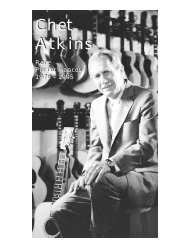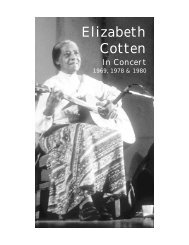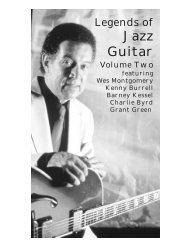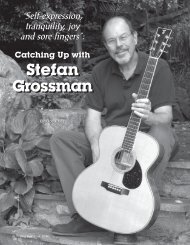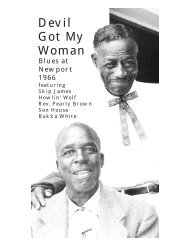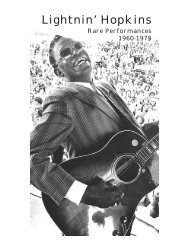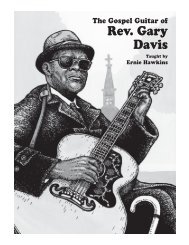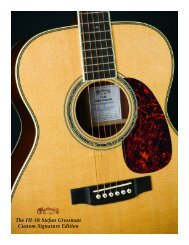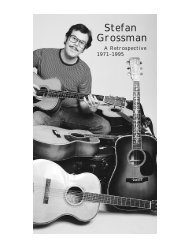Download PDF Booklet - Stefan Grossman's Guitar Workshop
Download PDF Booklet - Stefan Grossman's Guitar Workshop
Download PDF Booklet - Stefan Grossman's Guitar Workshop
You also want an ePaper? Increase the reach of your titles
YUMPU automatically turns print PDFs into web optimized ePapers that Google loves.
measure, but with accents that give each form its unique rhythmic<br />
feel. Observing an unaccompanied Irish fiddler performing<br />
dance pieces, you realize that the underlying pulse of the music<br />
is entirely imagined or “felt”. If the listener cannot figure out<br />
“where the beat is”, the convoluted twists and embellishments<br />
of melody render it all the more puzzling. But learning to listen<br />
is part of the experience. And if the performers don’t provide<br />
an obvious rhythm in the instrumentation, tapping feet in the<br />
audience usually will. A major challenge fingerstyle guitarists<br />
have undertaken is to construct the whole dance-band scenario<br />
– embellished melody playing over a throbbing dance rhythm –<br />
at once on the guitar.<br />
The earliest efforts in this direction on solo guitar were probably<br />
from American ragtime guitarists such as Dave Laibman,<br />
around 1960. He began to work out arrangements of fiddle tunes,<br />
and he was recorded in the early sixties by <strong>Stefan</strong> Grossman,<br />
who observes “These players, having successfully worked out<br />
things like arrangements of Scott Joplin’s piano rags on<br />
fingerstyle guitar, were looking for some new challenges. They<br />
began to find that challenge in arranging fiddle tunes”.<br />
At the same time, a new stylistic level of guitar playing was<br />
developing within the folk scene in England. The eclectic tastes<br />
of the 1960’s British fingerstylists guided them to experiment in<br />
certain musical directions. When the first wave of British acoustic<br />
nonclassical fingerpickers (notably Martin Carthy, Davey Graham,<br />
John Renbourn, Bert Jansch, and Dave Evans) began creating<br />
complex embellishments and arrangements of English folk<br />
music in the early and mid-1960’s, it was almost instinctive for<br />
them to begin working as well with melodies and tunes from the<br />
immediate environs of Ireland and Scotland. These players were<br />
the vanguard of a progression of guitarists who have focused<br />
both creative talent and sustained effort in bringing old music<br />
of the Celtic lands to fingerstyle guitar. Davey Graham – who in<br />
1960 recorded the bellwether tune She Moves Through The Fair<br />
– was one of the earliest experimenters, and appreciated not<br />
only the old Irish fiddle and pipe tunes, but made a passion of<br />
visiting countries in the middle east and north Africa to absorb<br />
and translate those musical styles too. None of this music was<br />
new – far from it – but it was a curiously novel idea to arrange it<br />
for solo steel-stringed “folk guitar”.<br />
The solo playing style created by these musicians did not<br />
become popular in a commercial sense, but it did become an<br />
influence for guitarists in the pop world, Paul Simon being a<br />
notable example. The complex fingerstyle arrangements, many<br />
employing alternate guitar tunings, have remained a small but<br />
significant extension of guitar repertoire. In the rediscovery of<br />
3



